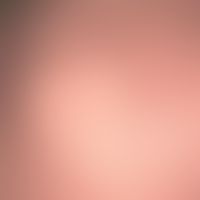Image diagnoses for "Hairlessness", "Scalp (hairy)"
35 results with 116 images
Results forHairlessnessScalp (hairy)

Folliculitis decalvans L66.2
Folliculitis decalvans: Initial changes, scalp appears swollen, with sunken, conspicuously prominent follicular structures, occasional tufts, individual follicles without hairline.

Nevus sebaceus Q82.5
Sebaceous nevus: clinical aspect of a sebaceous nevus in a few-month-old infant; only the slight plaque-like elevation of the hairless area indicates the actual diagnosis.

Lupus erythematodes chronicus discoides L93.0
Lupus erythematodes chronicus discoides: older, not (no longer) active, "discoid" lupus focus, healed under atrophy of skin and subcutis (complete destruction of the hair follicles, surface parchment-like smooth - see inlet).

Alopecia (overview) L65.9
Alopecia, androgenetic: typical infestation pattern in androgenetic alopecia.

Folliculitis decalvans L66.2
Folliculitis decalvans. 4 years of persistent, chronically active, progressive, red, follicle-related, rough, partly scaly, partly solitary, partly confluent papules on the capillitium of a 46-year-old man. In between, skin-coloured or white, hard, smooth, scarred plaques appear on which the follicles are completely missing.

Folliculitis decalvans L66.2
Folliculitis decalvans, circumscribed scarring alopecia with extensive reddening of the skin.

Microsphere B35.0
Microspore (Tina capitis caused by Microsporun canis) : Scaling and breaking off hair in the parting area in a 6-year-old girl. no itching. fungal culture: masses of Microsporum canis.

Alopecia marginalis L65.9

Superficial tinea capitis B35.0
Tinea capitis superficialis: non-inflammatory, blurred, alopecic foci in the parting area in a 6-year-old girl. fine whitish scales and breaking off hairs. no itching. fungal culture: masses of Microsporum canis.

Folliculitis decalvans L66.2
Folliculitis decalvans: developmental stages of the disease over a period of 7 years.

Frontal fibrosing alopecia L66.8
Alopecia, postmenopausal, frontal, fibrosing. scarred alopecia progressing centropedally from the periphery

Frontal fibrosing alopecia L66.8
Alopecia postmenopausal, frontal, fibrosing: uniform receding of the frontal and temporal hairline. moderately pronounced ulerythema ophryogenes. keratosis follicularis on the extensor extremities.

Alopecia neurodermitica L65.8

Folliculitis decalvans L66.2
Folliculitis decalvans: Alopecia like a footstep with fresh and older scars. Left picture: Inflammatory area with yellowish crusts. The process has been going on for several years, in attacks which last several months. Oral antibiotics improve the severity of the attacks.

Frontal fibrosing alopecia L66.8
Alopecia, post-menopausal, frontal, fibrosing: typical follicular inflammatory pattern (see frontal hairline). No symptoms. This results in a backward development of the forehead-hairline.









